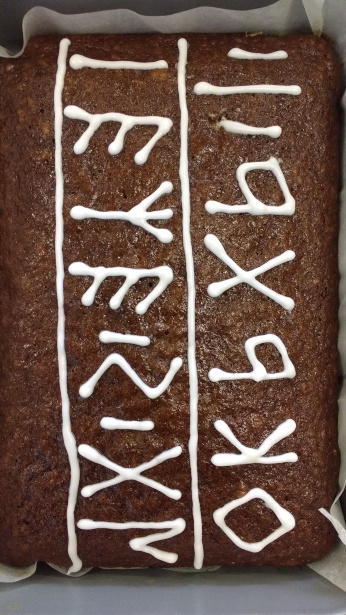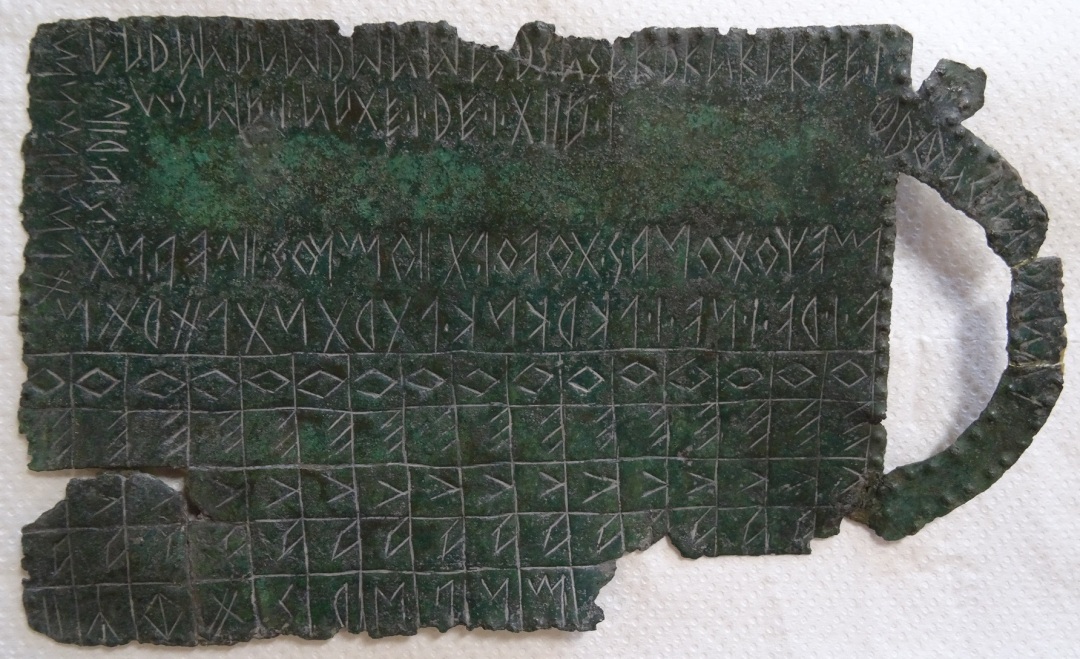I have been promising for a while to say something about the Venetic goddess of writing. Last term, my colleague Dr Katherine McDonald gave a short seminar series on the Venetic language, which was used in the Veneto area of Italy in the second half of the 1st millennium BC (at least, this is when most of the evidence for it dates from).
The Venetic language has clear affiliations with other Italic languages, which can be seen for example in some words that look very similar to what we find in Latin (such as ego for the first person pronoun “I”). It was written in an alphabet that seems to have been derived from an Etruscan alphabet (itself derived from the Greek alphabet), although it has some peculiarities of its own, including a complex system of punctuation for syllables.
You can see what the Venetic alphabet looks like in the ‘inscription’ shown in Figure 1 – which is not in fact the original inscription but a delicious cake version of it baked by my colleague Dr Anna Judson for the seminar!

Figure 1. Venetic inscription cake, baked by Anna Judson – see more HERE.
One of the reasons I wanted to mention Venetic on the CREWS blog is that we have plentiful evidence that Venetic speakers really valued writing – giving us an opportunity to think about context, one of the important focuses of the CREWS project.
Venetic inscriptions are found on a number of different object types, including gravestones, bronze tablets and mysterious little pebbles whose function we do not understand. Among the bronze tablets, one type of inscription that stands out is a type of abecedarium, listing the letters of the Venetic alphabet in order, possibly as a learning/teaching aid. But rather than just presenting the letters in a line, they are placed in a complex arrangement that requires turning the tablet to follow the sequence, and they also include extra entries to indicate which combinations require special syllabic punctuation. Figure 2 shows one of these tablets.

Figure 2. Venetic abecedarium, photo courtesy of Katherine McDonald.
In the pictured tablet, sadly the most recognisable part of the alphabet is missing – namely the beginning, which would have started with the familiar A, B, C type pattern we have seen in many other alphabets. The beginning would have been in the bottom right corner, proceeding towards the left (the first two letters you can see are M and N, in forms that look quite similar to Phoenician letters, with long tails).
Clearly care was being taken to give precise instruction in how to use the alphabet. The complexities of using it also point towards some restriction in writing, since it must have required training to use accurately. To this we can add that items associated with writing seem to have been relatively high-status, including tablets such as the one shown above, made out of bronze.

Figure 3. The Idalion Bronze from Cyprus, with a Greek inscription written in the Cypriot Syllabic writing system.
As we saw in the last post, on Handwriting in Roman London, however, it is quite likely that we are missing some document types because they were written on materials such as wood that have not survived. It is often suggested that tablets made in durable materials like bronze might be imitative of wooden tablets, and that could easily be the case here too. Some time in the future we will return to this theme and have a look at other possible imitations of wooden writing tablets, like the ivory Marsiliana d’Albegna tablet or the famous bronze tablet from Idalion in Cyprus, pictured above (Figure 3).
We don’t know what sorts of pieces of writing we may be missing, but what we do know is that bronze abecedarium tablets are not the only evidence of the importance of writing in the ancient Veneto area. Another common inscription type is on an item called a stylus, a pointed implement used for writing. These were again made of bronze, and the inscriptions were often dedications to a goddess called Reitia. Some of them are pictured below (Figure 4).

Figure 4. Venetic inscribed styli, photo courtesy of Katherine McDonald.
Why are people dedicating implements used for writing to Reitia? Well, although this is never expressed directly in an inscription, we think it is because she was the Venetic goddess of writing. Another indication that writing was considered an important technology in ancient Veneto!
If you would like to read more about Venetic, you can have a look at Katherine McDonald’s blog posts HERE and HERE. Katherine has just left us to take up a post in Exeter – we will miss her but we wish her the best of luck with her new job!
Next time, we’ll be returning with some exciting news about the CREWS project, so please keep coming back for more!
~ Pippa Steele (Principal Investigator of the CREWS project)
